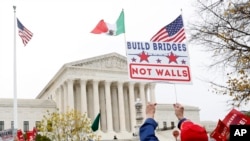With a 5-4 vote earlier this week, the U.S. Supreme Court allowed the Trump administration to deny legal residency to low-income immigrants who use or are deemed likely to rely on public assistance programs.
The decision overruled multiple lower courts that had blocked implementation of the “public charge" rule, which some call a wealth test, while litigation winds its way through America's court system.
How does the public charge rule work?
The rule sets forth new criteria for federal authorities in assessing immigrants who wish to become permanent legal residents of the United States. Officers from the U.S. Citizenship and Immigration Services will look at age, health, education, assets and income to identify those likely to become or remain dependent on the government for benefits including nutrition, housing and health care.
Using the rule, officials can deny green card applications or order immigrants removed from the country. Removal orders can be appealed but often lead to deportation.
What determines a public charge?
A person may be deemed a public charge if he or she has used one or more public benefits for more than 12 months in the aggregate within any 36-month period. Under the rule, receiving two benefits in one month counts as two months of consuming public resources.
Does the rule apply to all immigrants?
The rule does not apply to the process for becoming a U.S. citizen. It also does not apply to certain U.S. visa holders, including those who are in the United States to assist in the investigation or prosecution of crimes. U.S. officials have also said the public charge interpretation would not apply to people who already have green cards, to certain members of the military, refugees and asylum-seekers, or to pregnant women and children.
Why is the administration doing this?
Under U.S. law, a legal permanent resident can qualify for limited federal benefits. In most cases, the LPR must wait five years after achieving residency to apply for government assistance.
The Trump administration contends the United States should welcome immigrants based on demonstrated merit.
“Self-sufficiency and self-reliance are key American values not to be litigiously dismissed, but to be encouraged and adopted by the next generation of immigrants," acting Homeland Security Deputy Secretary Ken Cuccinelli said in a statement.
Cuccinelli added that the administration plans "to fully implement this rule" and is confident the policy will survive pending legal challenges.
How are advocacy groups reacting?
Backers of restricting immigration welcomed the Supreme Court's decision. “
The truth is that as a matter of fiscal responsibility, our government at every level needs to tighten work and productivity requirements to prevent either the abuse of, or chronic dependency on, our safety net programs, whether by longtime citizens or recent immigrants,” Ken Oliver, senior director of engagement at the conservative Texas Public Policy Foundation, said in a statement.
Immigrant rights groups, by contrast, are slamming the rule as discriminatory and unjust.
In a statement, the American Immigration Lawyers Association said the rule is the Trump administration's "latest attempt to construct an invisible wall blocking the pre-existing rights for legal immigrants."
Bruce Lesley, president of First Focus on Children, said the public charge rule targets and harms children.
“The mere threat of the public charge rule already has created a chilling effect that has forced thousands of children to drop health insurance, food assistance and other life-sustaining programs. We expect today’s decision to accelerate that damage and to harm millions of our country’s youngest and most vulnerable,” Lesley said.
What does the data show?
A 2019 analysis by the nonpartisan Migration Policy Institute (MPI) showed the rule gives the government broad discretion to deny admission to a large share of those who currently enter based on family relationships. Women, the elderly and children are often more likely to be in need of public assistance. Fear of the rule's enforcement could deter them from enrolling in assistance programs, even if they qualify.
Using census data, MPI calculated that 69% of green card holders had at least one factor that would be deemed negative under the rule. Forty-three percent had at least two negative factors and 17% had at least three.“
Taken as a whole, the public charge rule stands to slow the integration of immigrant families, overturn state choices regarding the services they have opted to provide to their residents, and to alter the composition of future immigration to the United States,” MPI concluded.
When does the new interpretation of the public charge rule take effect?
USCIS will likely announce an effective date in the next few days. The original starting date was postponed while nationwide injunctions stopped the rule. Those who already applied for adjustment of status and have pending applications with USCIS should not be affected by the rule.







